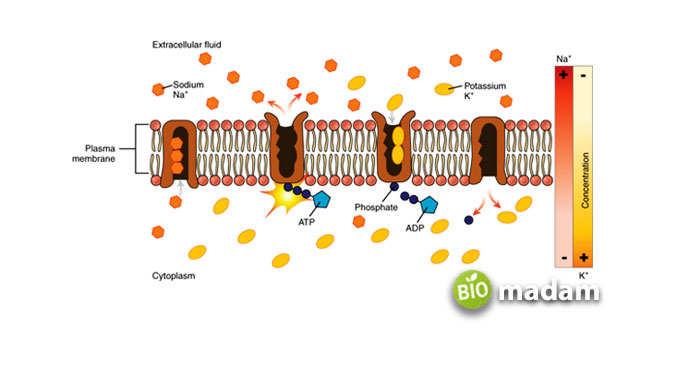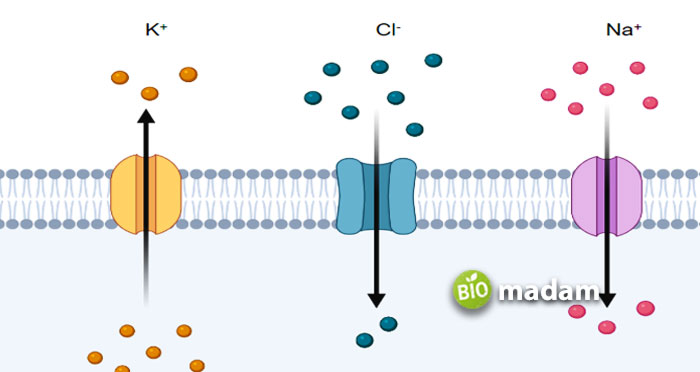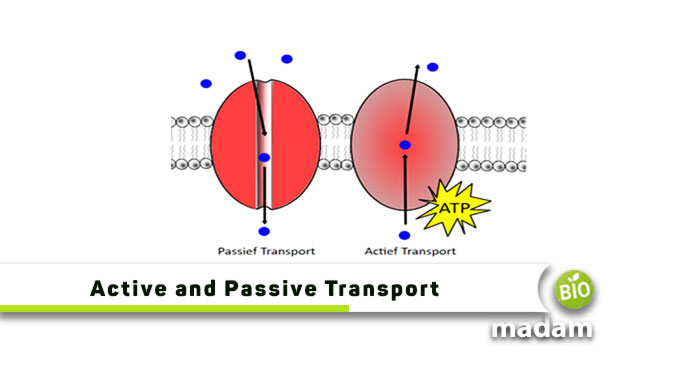Cellular transport is a critical function in eukaryotes and prokaryotes. It allows the movement of molecules and cellular components from one part to another. Most transport in the cell takes place through active or passive transport. The main difference between active and passive transport is the concentration of molecules in the initial and final location.
Comparison Table
| Characteristics | Active Transport | Passive Transport |
| Definition | Against the concentration gradient | Along the concentration gradient |
| Energy Requirement | Yes | No |
| Type of Process | Dynamic | Demanding |
| Speed | Fast | Slow |
| Molecules | Proteins, giant cells, complex sugars, ions | O2, water, lipids, CO2 and sex hormones |
| Movement | Low to high conc. | High to low conc. |
| Function | Molecular movement | Balance of nutrients |
| Selectivity | Selective | Non-selective |
| Need for Carrier Proteins | Yes | No |
| Direction | Unidirectional | Bi-directional |
| Influence of Temperature | Yes | No |
| O2 Influence | Yes | No |
| Effect of Metabolic Inhibitors | Yes | No |
What is Active Transport?
Active transport is a type of cellular transport in which substances move against a concentration gradient. This process indicates moving away from densely populated regions and into less densely populated ones. The use of energy and the participation of plasma membrane proteins like carrier proteins are important for this process.
Substances (ions, glucose, and amino acids) are actively transported across a biological membrane toward the region that already contains a high concentration of such molecules. Thus, active transport moves such molecules against their concentration gradient by employing chemical energy (such as ATP). Root hair cells, the villi covered with microvilli, are active transport sites within the cell.

Types of Active Transport
Active transport has two distinct types:
- Primary active transport
- Secondary active transport
Primary Active Transport
The breakdown of ATP, or adenosine triphosphate, provides the energy needed to push molecules across a membrane in the face of a concentration gradient. There are ATP molecules on the cytosolic side of the membrane, so all ATP-powered pump families must have ATP binding sites. Active transport relies primarily on chemical energy from outside the cell, most often in the form of ATP.
The sodium-potassium pump is often cited as an example of primary active transport because it is the most crucial pump in the cell membranes of animal cells. Sodium ions leave the cell, while potassium ions enter the cell through active transport.
Secondary Active Transport
By utilizing pore-forming proteins, secondary active transport aids in the transport of cations and anions. This method employs an electromagnetic gradient to create the cellular membrane channels. Secondary active transport aids the movement of other molecules due to the concentration gradient. Cotransporters are responsible for creating this gradient.
There are two basic kinds of cotransporters. They transport the solute and the ions across the cell membrane but in opposite directions. While operating, ions and solutes move in the opposite direction in antiporters. The solute travels against the concentration gradient with antiporters while the ions follow the concentration gradient. A good case in point is the sodium-calcium exchanger.
Significance of Active Transport
Many biological functions rely on active transport. It plays a role in numerous biochemical processes within mitochondria and chloroplasts, such as proton gradient generation and chemosynthesis.
Eukaryotic cells require active transport of lipids, carbohydrates, and proteins via protein pumps as they cannot diffuse. Large, insoluble molecules need active transport to enter the cell.
What is Passive Transport?
The process in which biochemicals move from an area of higher concentration to a region of lower concentration is passive transport. In this process, the transportation of the molecules does not require cellular energy. Passive transport carries all easily soluble particles. This procedure is essential to keep a cell’s internal environment stable and balanced.
Passive transport removes all the waste molecules from the cell, including water and carbon dioxide. In the meantime, essential nutrients like oxygen are transported throughout the cell. Concentration equilibrium is the driving force behind passive transport. The lungs, liver, and kidneys all have this transport system.

Types of Passive Transport
Types of passive transport include osmosis, diffusion, and facilitated diffusion.
- Osmosis
- Simple diffusion
- Facilitated diffusion
- Filtration
Osmosis
During osmosis, water and possibly other molecules or compounds pass through a cell’s selectively permeable membrane. Many factors can change how this transport works. Some of these include the solute potential of a molecule and the pressure potential across a cell membrane. Still, the cell’s reduced negative water potential is a significant contributor to passive transport.
Simple Diffusion
The transportation of molecules or solutes across a semipermeable membrane is simple diffusion. Since non-polar molecules are most likely to use simple diffusion, keeping the distance between them at a minimum will ensure the best possible flow.
Facilitated Diffusion
The transmembrane domain of integral proteins that allows molecules or ions to move passively across the cell membrane is facilitated diffusion. Several transport proteins track the diffusion of polar molecules and large ions during facilitated diffusion. Proteins that transport other proteins are carrier proteins, usually glycoproteins. The large, insoluble molecules require a carrier to cross the plasma membrane. There is no need for internal or external energy for this.
Filtration
Molecular diffusion along a concentration gradient is what we call filtration. Hydrostatic pressure, generated by the cardiovascular system (CVS), aids the transport of water and other soluble biochemical molecules or substances across the cell membrane. The term “filtration” describes this process because the cell membrane allows only water-soluble substances to pass through its pore.
Significance of Passive Transport
Passive transport ensures stability within the cell. Diffusive transport provides for the removal of wastes like carbon dioxide and water and the entry of oxygen and nutrients for cellular metabolism. Maintaining a balance between the cytosol, cytoplasm, and the extracellular fluid is another crucial function of passive transport.
Difference between Active and Passive Transport
Definition
Active Transport
Active transport pumps molecules across the cell membrane against the concentration gradient, using ATP as fuel (energy).
Passive Transport
Passive transport involves the movement of molecules along a concentration gradient through the cell membrane without using ATP.
Energy Requirement
Active Transport
Active transport needs cellular energy to transport substances.
Passive Transport
Whereas, passive transport does not need cellular energy to transport substances.
Method
Active Transport
This method is fast-paced and dynamic.
Passive Transport
At the same time,it is a relatively slow and physically demanding method.
Transportation of Particles
Active Transport
Active transport moves all molecules, including different types of proteins, giant cells, complex sugars, and ions.
Passive Transport
However, the transport of all soluble molecules, such as oxygen, water, carbon dioxide, lipids, and sex hormones, relies on this system.
Circulation
Active Transport
Active transport relies on the movement from a low-concentration area to a high-concentration one.
Passive Transport
Meanwhile, passive transport involves movement from a more concentrated area to a less concentrated one.
Significance
Active Transport
Amino acids, carbohydrates, and lipids must enter the eukaryotic cells through protein pumps, which require active transport. For survival, these substances either cannot disperse or diffuse too slowly.
Passive Transport
Contrarily, it keeps the cell’s balance intact. As nutrients and oxygen diffuse into the cell, wastes (like carbon dioxide and water) diffuse out of the cell.
Functions
Active Transport
Active transport plays a crucial role by allowing molecules to cross the cell membrane, thereby upsetting the equilibrium maintained by diffusion.
Passive Transport
On the contrary, passive transport is responsible for keeping the cytosol and extracellular environment in a dynamic balance of water, nutrients, gasses, and wastes.
Selectivity
Active Transport
Active transport is a very demanding and selective process.
Passive Transport
Passive transport, in contrast, is a non-selective process.
Need of Carrier Protein
Active Transport
Carrier proteins are essential for active transport.
Passive Transport
Opposed to the former, carrier proteins are not necessary for passive transport.
The Direction of Transport
Active Transport
Active transport is a one-way process.
Passive Transport
On the other hand, passive transport is bidirectional.
Influence of Temperature
Active Transport
Temperature plays a role in how this process proceeds.
Passive Transport
Alternatively, temperature does not affect passive transport.
Oxygen Content
Active Transport
The absence or reduction of oxygen slows or halts this process.
Passive Transport
But, the oxygen concentration makes no difference to this procedure.
Metabolic Inhibitors
Active Transport
Metabolic inhibitors can affect and stop active transport.
Passive Transport
On the contrary, metabolic inhibitors do not affect modes of passive transportation.
Examples
Active Transport
Endocytosis, exocytosis, secretion into the circulation, and the sodium/potassium pump are all examples of active transport.
Passive Transport
The three primary forms of passive transport are different types of diffusion and osmosis.
The Bottom Line
Active and passive transport are the main types of transport within and outside the cell. They allow the movement of molecules across a concentration gradient. The main difference between active and passive transport is the involvement of energy in active transport. Osmosis and diffusion are common examples of passive transport within the cell. At the same time, sodium potassium pumps, endocytosis, exocytosis, and secretion into circulation are active transport.
FAQs
What are the similarities between active and passive transport?
Active and passive transport allow the movement of materials within the cell and removal of waste products. They take place in the presence of a concentration gradient in the cell.
What is the difference between active and passive diffusion?
Active diffusion pushes molecules against the concentration gradient by the use of energy while passive diffusion enables the movement of molecules across the concentration gradient.
What are the types of passive transport?
Passive transport is categorized into four types according to their processes. The types of passive transport are simple diffusion, facilitated diffusion, filtration, and osmosis.

Jeannie has achieved her Master’s degree in science and technology and is further pursuing a Ph.D. She desires to provide you the validated knowledge about science, technology, and the environment through writing articles.

